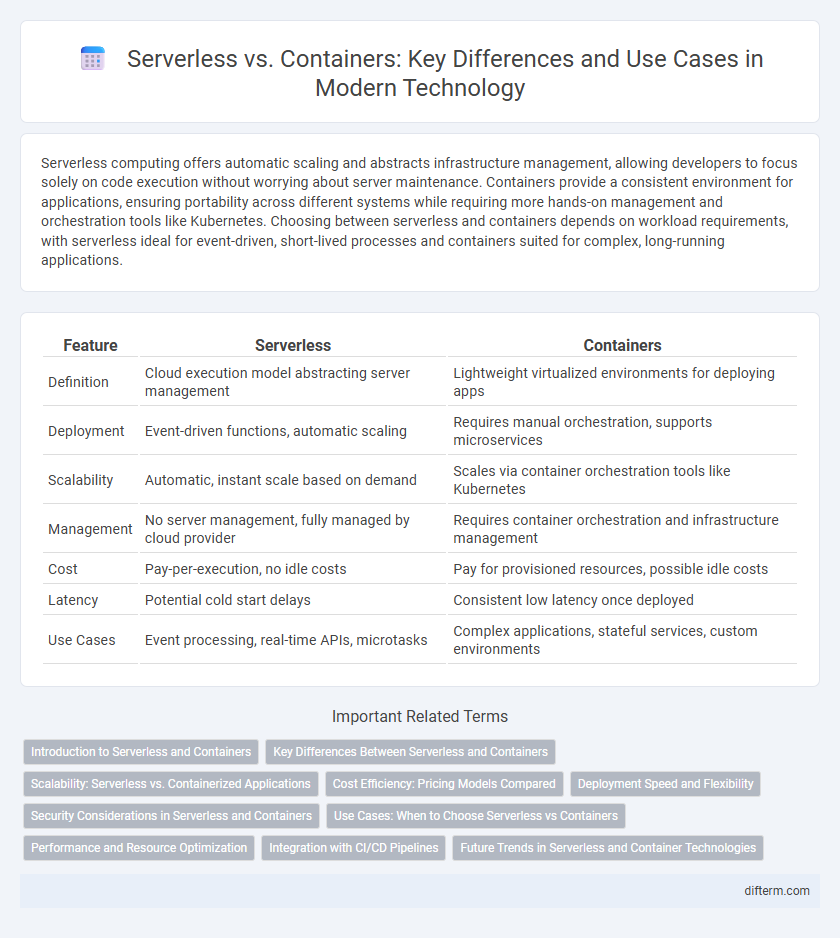Serverless computing offers automatic scaling and abstracts infrastructure management, allowing developers to focus solely on code execution without worrying about server maintenance. Containers provide a consistent environment for applications, ensuring portability across different systems while requiring more hands-on management and orchestration tools like Kubernetes. Choosing between serverless and containers depends on workload requirements, with serverless ideal for event-driven, short-lived processes and containers suited for complex, long-running applications.
Table of Comparison
| Feature | Serverless | Containers |
|---|---|---|
| Definition | Cloud execution model abstracting server management | Lightweight virtualized environments for deploying apps |
| Deployment | Event-driven functions, automatic scaling | Requires manual orchestration, supports microservices |
| Scalability | Automatic, instant scale based on demand | Scales via container orchestration tools like Kubernetes |
| Management | No server management, fully managed by cloud provider | Requires container orchestration and infrastructure management |
| Cost | Pay-per-execution, no idle costs | Pay for provisioned resources, possible idle costs |
| Latency | Potential cold start delays | Consistent low latency once deployed |
| Use Cases | Event processing, real-time APIs, microtasks | Complex applications, stateful services, custom environments |
Introduction to Serverless and Containers
Serverless computing abstracts infrastructure management by automatically provisioning resources, enabling developers to focus on code execution without server maintenance. Containers encapsulate applications and their dependencies into lightweight, portable units that run consistently across different environments. Both technologies streamline deployment but differ in operational control, scalability, and resource allocation, shaping modern cloud-native architectures.
Key Differences Between Serverless and Containers
Serverless computing abstracts infrastructure management by automatically scaling functions triggered by events, eliminating the need for server provisioning, while containers encapsulate applications and their dependencies, offering consistent environments across development and production. Containers provide greater control over runtime environments, enabling custom configurations and long-running processes, whereas serverless functions typically handle stateless, short-lived tasks. Cost models also differ: serverless charges based on actual execution time and resource usage, while containers often incur costs for allocated compute resources regardless of utilization.
Scalability: Serverless vs. Containerized Applications
Serverless architectures automatically scale functions based on demand, eliminating the need for manual resource management and reducing idle capacity costs. Containerized applications require orchestrators like Kubernetes to handle scalability, providing fine-grained control over resource allocation and scaling policies. Serverless excels in unpredictable workloads with rapid scaling, while containers offer consistent performance and scalability for complex, stateful applications.
Cost Efficiency: Pricing Models Compared
Serverless computing offers a pay-as-you-go pricing model that charges only for actual usage, reducing costs during low traffic periods. Containers typically require provisioning of fixed resources, which can lead to higher expenses when demand is underestimated or resources are underutilized. Analyzing cost efficiency reveals serverless as ideal for variable workloads, while containers suit predictable, steady traffic patterns with potentially lower overhead at scale.
Deployment Speed and Flexibility
Serverless platforms offer rapid deployment by abstracting infrastructure management, enabling developers to focus solely on code execution without provisioning resources. Containers provide flexibility through encapsulated environments, allowing consistent application deployment across diverse systems while requiring orchestration tools for scaling and updates. Deployment speed in serverless is generally faster due to automatic scaling and event-driven architecture, whereas containers offer greater control and customization, impacting flexibility for complex, stateful applications.
Security Considerations in Serverless and Containers
Serverless architectures minimize the attack surface by abstracting infrastructure management, reducing direct exposure to operating system vulnerabilities. Containers offer more control over security configurations, enabling isolation through namespaces and cgroups but require rigorous patch management and runtime security monitoring to prevent container escape attacks. Both approaches demand robust identity and access management (IAM) policies, encryption protocols, and continuous compliance auditing to ensure secure deployment environments.
Use Cases: When to Choose Serverless vs Containers
Serverless architecture excels in event-driven applications, rapid prototyping, and unpredictable traffic patterns due to automatic scaling and reduced infrastructure management. Containers are ideal for complex, long-running workloads, microservices requiring consistent runtime environments, and situations needing greater control over system resources and dependencies. Choosing serverless is optimal for cost-efficiency and agility in ephemeral tasks, while containers suit scalable applications with stable, persistent processes.
Performance and Resource Optimization
Serverless computing offers automatic scaling and efficient resource utilization by dynamically allocating resources only during function execution, reducing idle infrastructure costs. Containers provide consistent performance through isolated environments and configurable resource limits, enabling optimized workload distribution across clusters. Comparing both, serverless excels in event-driven applications with sporadic traffic, while containers deliver superior control and predictability for sustained high-performance workloads.
Integration with CI/CD Pipelines
Serverless architectures streamline integration with CI/CD pipelines by enabling automated deployment through API-driven workflows, reducing infrastructure management overhead. Containers offer greater flexibility in CI/CD integration by supporting consistent environments and facilitating complex multi-stage pipelines using orchestration tools like Kubernetes. Choosing between serverless and containers depends on the need for scalability, deployment speed, and control within continuous integration and delivery processes.
Future Trends in Serverless and Container Technologies
Serverless and container technologies are evolving rapidly to address scalability, cost efficiency, and development speed in cloud-native applications. Future trends highlight increased integration of artificial intelligence and machine learning to optimize workload distribution and resource management in both serverless functions and container orchestration. Enhanced security protocols and multi-cloud support are also anticipated to become standard, driving broader adoption across industries.
Serverless vs Containers Infographic

 difterm.com
difterm.com